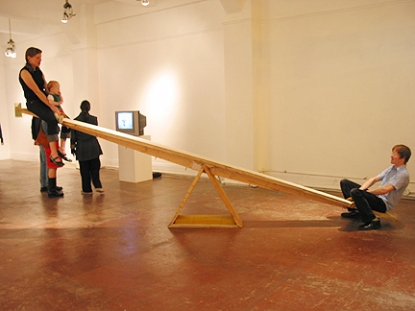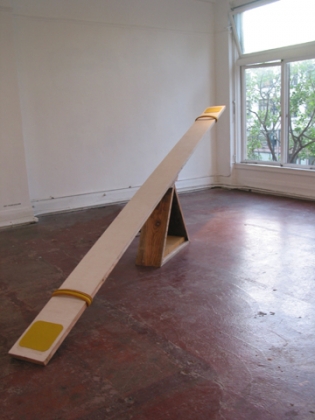Feature: Reviews
Flyaway
- The Luggage Store Gallery
- San Francisco
- April 12 - May 10, 2002
Curated by Amanda Eicher, with artists Lara Allen, Robert Arnold, Sarah Cain, Amanda Eicher, Amy Franceschini, Shaun O’Dell, Alena S. Rudolph, and Yutaka Sho
Writing about Flyaway while seated in an airplane seemed fitting. The notion was less obnoxious than it sounds; I wanted to try experiencing the “freedom, fancy, and escape” that the exhibition’s press release informed me were represented by flight. I sat patiently as the bags were stowed in the overhead bins and the doors were closed for take-off, and waited, pen in hand, for flying to be something more than a glorified bus ride, meant only to expedite the movement between point A and point B.
But the thing about flying is that it exists in a realm where time and space are distorted, where hours are lost or gained as if by magic, where personal space is reduced to one and a half square feet plus a tray table. Without a visual reference, your sense of movement slows down, until it feels as if you aren’t moving at all. This sense of stalling is recorded in several of the most resonant works in Flyaway, which loosely organizes the work of nine artists around the concept of flying. Of these nine, Shaun O’Dell, Amy Franceschini, Sarah Cain, and Robert Arnold recognize that flying is less about movement than about arrested motion.
Displayed on a small monitor, Shaun O’Dell’s video shows a tree hanging upside down, dangling in the V shape of a valley. It should be falling but is instead suspended on the screen, from time to time gently swaying in an imagined breeze. In the Dan Graham style of boring videos, O’Dell methodically makes clear that something is happening though all appears still. The image is not frozen in time but suspended within it, waiting for something to happen.
Something does happen to Amy Franceschini’s fourteen-foot seesaw. The wooden platform with two yellow seats sits idle, waiting for gallerygoers to climb aboard. Smudged with footprints and dirtied from use, the plank offers a refreshing ride. But it is more poignant when empty. Jutting from the northeast corner of the gallery, it marks the space as without motion, as denied motion.
Sarah Cain’s painted wooden panel hung next to a pattern of smudges and burns made directly on the wall also leaves a record of movement that has since stopped. A moth has been captured in the thick green paint, its flight truncated by an unfortunate landing. Indices of arrested motion, the dead bug and the smears of dirt, soot, and ink on the wall intimately record actions brought to a halt.
Only one artist overtly references airplanes in his work. Robert Arnold’s striking photos of passengers taken while flying make visually apparent how disconnected the scene outside an airplane window is from the world on the ground. It is almost easier to imagine everything outside the cabin as a video. Arnold presents a highly mediated flying experience, tinged with Baudrillard-esque paranoia, through satellite maps and aerial views.
Flyaway is filled with excellent work; other pieces worthy of special note are Christine Shields’ mystical escape artists, drifting up the gallery wall, and Alena S. Rudolph’s pigmented scenes of homes and the power lines that supply them. But the curator assumed that metaphors of taking flight are wrapped up with aspirations. Hours later, I am still stuck in this plane. No fancy or freedom to be found.
Flyaway was on view at the Luggage Store Gallery, San Francisco from April 12 - May 10, 2002.


